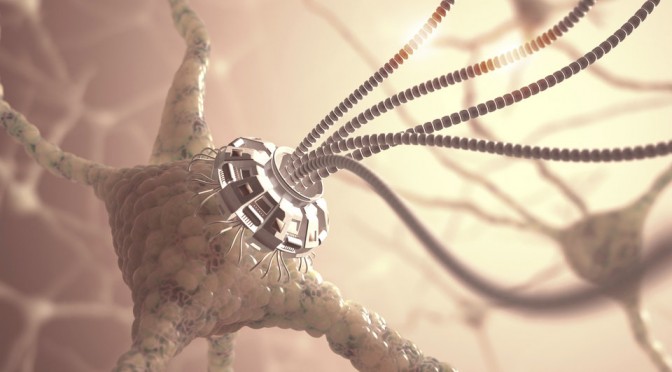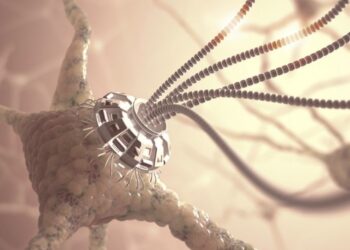The rapid advancements in nanotechnology have opened a new frontier in biomedical innovation: wearable nanobots. These microscopic, intelligent machines are envisioned as future companions inside or on our bodies, assisting in diagnostics, treatments, and even enhancing human abilities.
As we enter an era where machines shrink to the molecular level and merge with wearable tech, the idea of integrating nanobots with wearable systems moves from science fiction into plausible reality. The wearable nanobot future holds immense promise for revolutionizing healthcare, military, athletic performance, and even day-to-day life.
This article explores what wearable nanobots are, how they work, their current development stage, future applications, challenges, and ethical considerations. Welcome to a future where machines live on us, in us, and work for us—in real time.
What Are Wearable Nanobots?

Wearable nanobots are nanoscale robotic devices—ranging from 1 to 100 nanometers—designed to be embedded in or integrated with wearable devices like smartwatches, skin patches, or textiles. Some can also be injected or applied directly to the body and controlled externally via wearable interfaces.
These nanobots can:
Monitor biological signals (e.g., heart rate, glucose levels)
Deliver targeted medications
Repair tissues or cells
Clean toxins or pathogens from the bloodstream
Interface with wearable systems for real-time data analytics
Unlike conventional wearables that monitor from outside, nanobots interact directly at the cellular or molecular level, providing deeper insights and faster response mechanisms.
How Do Wearable Nanobots Work?
Wearable nanobots combine nanotechnology, biotechnology, AI, and material science. Here’s how they generally function:
A. Deployment
Nanobots can be delivered through patches, skin tattoos, smart clothing, or even micro-needles. Some enter the bloodstream or stay on the skin’s surface.
B. Sensing & Monitoring
They detect chemical and electrical signals from cells, tissues, and bodily fluids. These include biomarkers for disease, infection, or stress.
C. Processing Data
Using onboard microprocessors or AI-assisted analysis from wearable devices, nanobots interpret complex biological data instantly.
D. Action Execution
Once an abnormality is detected, nanobots can take action—such as releasing medication, generating electrical impulses, or alerting the wearer.
E. Feedback Loop
They continuously relay data to wearable hubs (like smartwatches) or cloud-based systems for storage, diagnostics, and decision-making.
Applications of Wearable Nanobots
1. Health Monitoring and Preventive Care
A. Real-Time Glucose Tracking
For diabetics, nanobots can provide minute-by-minute glucose readings and auto-adjust insulin delivery.
B. Cancer Detection
Nanobots can detect cancer biomarkers before physical symptoms arise—offering unparalleled early detection.
C. Cardiovascular Monitoring
They can analyze heart rhythms, detect plaque build-up, and even prevent heart attacks by unclogging arteries.
D. Neurofeedback for Mental Health
Integrated into headbands or neural wearables, nanobots can monitor neurotransmitter levels and recommend mental wellness activities.
2. Drug Delivery Systems

Wearable nanobots allow targeted drug delivery, reducing side effects and increasing efficacy.
A. Chemotherapy Without Harmful Side Effects
Nanobots can deliver drugs directly to cancer cells, sparing healthy tissue.
B. Pain Management
For chronic pain sufferers, nanobots can release painkillers in micro-doses exactly when needed, avoiding addiction risks.
C. Vaccination and Immunotherapy
Smart vaccines using nanobots can adapt to virus mutations and provide dynamic immune responses.
3. Disease Treatment and Healing
A. Tissue Repair
Nanobots can stimulate healing at the cellular level, including for burns, ulcers, and nerve damage.
B. Anti-Bacterial Action
They can locate and destroy bacteria or viruses using physical means (like nano-lasers) or chemical methods.
C. Internal Surgery Assistance
In future surgeries, nanobots may perform micro-scale operations, eliminating the need for scalpels and reducing recovery time.
4. Human Augmentation and Performance Enhancement
A. Cognitive Enhancement
Nanobots could regulate neurotransmitter levels to improve memory, attention, and learning.
B. Muscle Boost and Fatigue Resistance
Athletes may benefit from nanobots that optimize oxygen use and reduce lactic acid buildup.
C. Vision and Hearing Improvement
Linked with AR devices, nanobots can enhance sensory perception or restore lost capabilities.
5. Military and Space Applications
A. Soldier Health Monitoring
Real-time health metrics and trauma response improve battlefield survival rates.
B. Radiation Resistance in Space
Nanobots may repair cellular radiation damage, enabling safer long-term space travel.
C. Combat Enhancement
Potential for boosting reflexes, endurance, and situational awareness in high-stress environments.
Current Technological Developments

While fully autonomous wearable nanobots are not yet commercialized, progress is accelerating:
Stanford University developed micro-robots for drug delivery with magnetic control.
MIT created nanosensors that detect early-stage cancer.
Caltech is exploring AI-controlled nanobots that mimic white blood cells.
Google’s Verily works on smart contact lenses with embedded nanosensors.
Most current efforts are hybrid systems, where nanosensors interface with wearable devices to provide more depth and control.
Challenges to Overcome
A. Energy Supply
Powering nanobots remains a challenge due to their size. Research focuses on energy harvesting from the body (thermal, motion, or chemical).
B. Biocompatibility
Nanobots must not trigger immune responses or cause toxicity. Biodegradable or body-friendly materials are in development.
C. Precision Control
Guiding nanobots accurately within the body is difficult. External magnetic or acoustic control systems are being refined.
D. Data Privacy
Continuous biological monitoring raises concerns about surveillance, health data breaches, and consent.
E. Cost and Accessibility
High development costs could restrict access to wealthy populations unless scaled effectively.
Ethical and Social Considerations
A. Informed Consent
Will patients truly understand what nanobots do inside their bodies?
B. Autonomy vs Control
Can individuals turn off or opt out of nanobot systems embedded within their wearables?
C. Digital Divide
Will only wealthy nations benefit, deepening global inequality?
D. Military Ethics
Should soldiers be enhanced with tech that potentially alters moral judgment or pain perception?
E. Regulatory Oversight
Current laws don’t fully address microscopic agents inside the human body—leaving grey areas in liability and safety.
The Path Ahead: 2030 and Beyond
By 2030, experts predict:
Consumer-grade smart patches with nano-diagnostic tools
Cancer-targeting nanobots for personalized treatment
Smart textiles embedded with micro-robots for fitness and health tracking
Hybrid human-AI systems powered by nanotech
As AI improves and material science advances, wearable nanobots will likely evolve into everyday wellness tools, just as smartphones have become ubiquitous today.
Why This Technology Matters
The convergence of AI, nanotech, and wearable devices is transformational. It shifts the paradigm from reactive medicine to proactive, continuous care—all without human intervention.
Moreover, it may extend lifespan, improve life quality, and create a new category of augmented humans.
Conclusion: Embracing a Nano-Enabled Tomorrow
The wearable nanobot future is both exciting and complex. It offers the promise of near-perfect health monitoring, targeted treatment, and even cognitive or physical enhancement. But this future also demands responsible innovation, ethical foresight, and equitable access.
Nanobots may soon be as common as smartphones—except you won’t carry them in your pocket. You’ll wear them, and they’ll work silently within, protecting, healing, and enhancing you 24/7.
The era of nano-wearable symbiosis has begun. The question isn’t whether nanobots will become part of us—it’s whether we’re ready for what that means.






